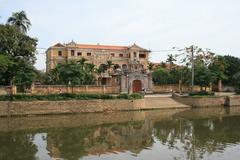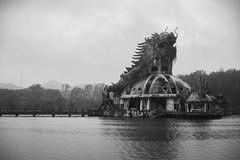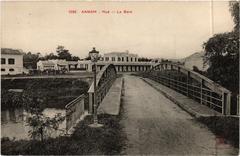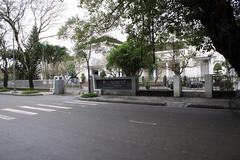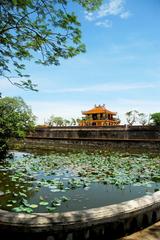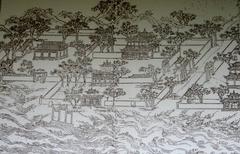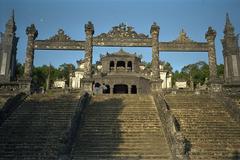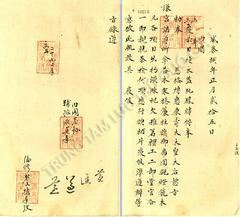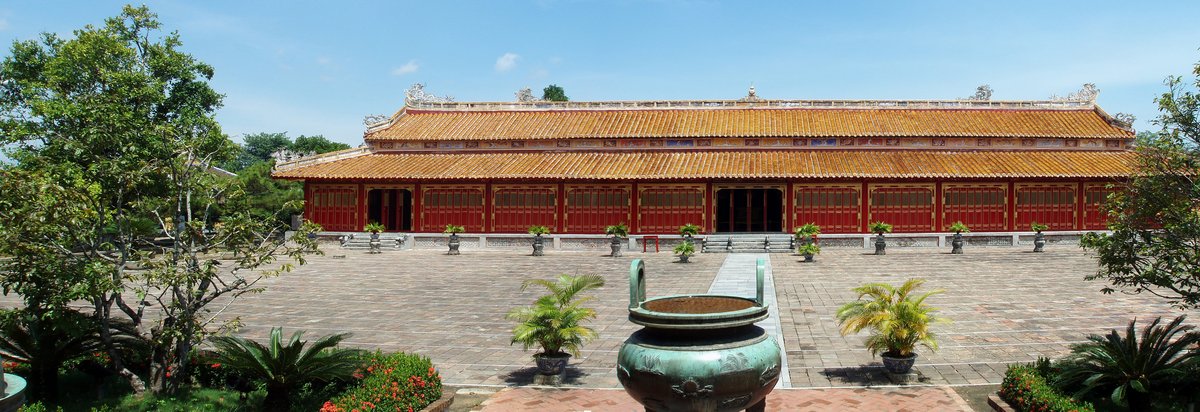
Imperial City of Hue, Vietnam: Visiting Hours, Tickets, and Historical Sites Guide
Date: 14/06/2025
Introduction
Nestled along the tranquil Perfume River in central Vietnam, the Imperial City of Hue stands as a monumental testament to the grandeur of the Nguyen Dynasty, Vietnam’s last imperial family. Established in the early 19th century by Emperor Gia Long, this UNESCO World Heritage Site showcases a harmonious blend of history, culture, and architectural splendor. Modeled after Beijing’s Forbidden City but distinctly Vietnamese, the Hue Citadel spans over 500 hectares, featuring imposing walls, ornate palaces, sacred temples, and lush gardens, all meticulously designed according to feng shui principles.
The Imperial City served as Vietnam’s political, religious, and cultural heart for nearly 150 years, witnessing both splendid royal ceremonies and turbulent historical events. Despite wars and periods of decline, ongoing restoration efforts have preserved its symbolic resilience. Today, the Imperial City invites travelers to explore iconic landmarks—such as the Ngo Mon Gate, Thai Hoa Palace, Forbidden Purple City, and Mieu Temple—and experience vibrant cultural festivals like the biennial Hue Festival. Whether you are a history enthusiast, cultural explorer, or first-time visitor, this guide provides all the practical information and historical context you need to plan your trip and fully appreciate the timeless beauty and significance of the Imperial City of Hue (History Hit, Vietnamplus, Viet Nam Travel).
Table of Contents
- Introduction
- Historical and Cultural Significance
- Layout and Defensive Architecture
- Palaces, Halls, and Courtyards
- Temples, Shrines, and Theatres
- Gates and Defensive Features
- Gardens, Pavilions, and Decorative Elements
- Key Attractions Beyond the Citadel
- Visiting the Imperial City: Practical Information
- Hue Festival 2025: Highlights and Visitor Information
- Essential Tips for Visitors
- Frequently Asked Questions (FAQs)
- Location and Access
- Facilities and Accessibility
- Sustainable Tourism
- Summary and Visitor Recommendations
- References and Further Reading
Historical and Cultural Significance
Foundation of the Imperial City
The Imperial City of Hue, or Kinh Thành Huế, was founded in 1804 by Emperor Gia Long, becoming the seat of the Nguyen Dynasty from 1802 to 1945. The site was carefully selected and constructed with the help of thousands of laborers, using feng shui principles to harmonize with the Perfume River and Ngu Binh Mountain (History Hit, afuncouple.com).
Architectural Grandeur and Urban Design
Covering over 500 hectares, the Imperial City is surrounded by a 7-kilometer moat and fortified walls. The complex is organized in concentric zones: the Citadel (outer), the Imperial City (middle), and the Forbidden Purple City (inner), the latter reserved for the emperor’s private use. The layout reflects the ideals of harmony between humans and nature, and the architecture blends traditional Vietnamese with foreign influences (History Hit, World Heritage Site).
Political, Religious, and Artistic Center
For nearly 150 years, Hue was the political, spiritual, and artistic nucleus of Vietnam, hosting royal rituals, court music, and the flourishing of Confucian, Buddhist, and Taoist traditions. The site’s artistic treasures include the Ngo Mon Gate, Thai Hoa Palace, Nine Dynastic Urns, and Hien Lam Pavilion, all richly adorned with intricate motifs and glazed tiles (hoiantravel.com.vn, afuncouple.com).
Turbulence, Restoration, and Resilience
The Imperial City suffered significant damage during the First Indochina War and the 1968 Tet Offensive but has since been the focus of major restoration campaigns, supported by UNESCO and international partners. These efforts ensure ongoing preservation of Hue’s architectural and cultural legacy (History Hit, World Heritage Site).
Layout and Defensive Architecture
The Imperial City’s design reflects a blend of ceremonial grandeur and military might. Encircled by a 2.5-kilometer moat and massive brick walls up to 6 meters high, the site features ten monumental gates, with the iconic Ngo Mon Gate serving as the main southern entrance and imperial audience platform. Within, the city is further subdivided—culminating in the Forbidden Purple City, once reserved solely for the emperor (walkaroundvietnam.com). The layout follows strict geomantic principles, with the Perfume River to the south and Ngu Binh Mountain to the north (vietvisiontravel.com).
Palaces, Halls, and Courtyards
- Thai Hoa Palace: The ceremonial heart of the Imperial City, featuring 80 lacquered columns and a spectacular wooden ceiling. Recently restored, it is open daily during official visiting hours (vietnamplus.vn).
- Kien Trung Palace: Reopened after extensive restoration, it showcases a blend of Vietnamese, French, and Chinese styles.
- Forbidden Purple City: Once strictly off-limits except to the emperor and his close attendants; several pavilions and gardens are now accessible after restoration.
Temples, Shrines, and Theatres
- The Mieu Temple Complex: Dedicated to the worship of Nguyen emperors and ancestors, with ornate shrines and dragon motifs.
- Duyen Thi Duong Royal Theatre: Vietnam’s oldest surviving royal theater, hosting traditional court music and performances.
Gates and Defensive Features
- Ngo Mon Gate: The grandest entrance, with five portals and an upper pavilion that provides panoramic views. Entry to the citadel is through this gate.
- Other Gates and Moats: Hien Nhon and Chuong Duc gates feature elaborate carvings. The moat, fed by the Perfume River, enhances the site’s feng shui.
Gardens, Pavilions, and Decorative Elements
Serene gardens, lotus ponds, and pavilions like Co Ha Garden offer tranquil spaces that embody Confucian ideals of harmony.
Key Attractions Beyond the Citadel
- Royal Tombs: Notable tombs include Khai Dinh (fusion of Vietnamese and European styles), Tu Duc (poetic lakeside setting), and Minh Mang (Confucian symmetry).
- Thien Mu Pagoda: The city’s oldest religious site, with the iconic seven-story Phuoc Duyen Tower.
- Hue Museum of Royal Antiquities: Housed in Long An Palace, it showcases imperial artifacts (photography not allowed inside).
Visiting the Imperial City: Practical Information
Opening Hours
- Summer (April–September): 7:00 AM – 5:30 PM
- Winter (October–March): 7:30 AM – 5:00 PM
Some holidays and special events may affect these hours (Vietnam Vacation, teamthomastravels.com).
Ticket Prices (2025)
- Imperial City: Adults 200,000 VND; Children (7–12 years old, 0.8–1.3m tall) 40,000 VND; under 6 years free (Vietnam Vacation).
- Combo Tickets:
- 3-site combo (Imperial City, Minh Mang Tomb, Khai Dinh Tomb): Adults 420,000 VND; Children 80,000 VND
- 4-site combo (Imperial City, Minh Mang, Tu Duc, Khai Dinh): Adults 530,000 VND; Children 110,000 VND (Thaiest)
Tickets are available at main gates, online, or via the “Di tích Huế” app (Kampatour).
Entry Procedures
- Single tickets valid for one entry on the day of purchase; combo tickets valid for two consecutive days.
- Children’s tickets may require proof of age or height.
- Guided tours in English, French, or Vietnamese are available for booking.
Hue Festival 2025: Highlights and Visitor Information
Overview
The Hue Festival is Vietnam’s premier cultural event, held biennially in the Imperial City. The 2025 edition celebrates the 50th anniversary of Thua Thien Hue’s liberation, featuring over 60 activities spanning 7–10 days (vietnambudgetcarrental.com).
Festival Structure and Themes
Divided into seasonal programs—Spring, Summer, Autumn, Winter—the festival includes performances, exhibitions, and community activities (vietnam.travel).
Visiting Hours and Tickets
- Imperial City during festival: 8:00 AM – 5:00 PM
- General Admission: 200,000 VND; special events may require additional fees.
- Tickets: Available online and at entrance gates (lotuseaters.travel).
Festival Highlights
- Opening Ceremony & Fireworks: Grand displays with traditional and modern music (ulatravelvn.com).
- Royal Court Music and Theater: UNESCO-listed performances and mask parades.
- Ao Dai Fashion Shows and International Art: Celebrating Vietnam’s iconic dress and global collaborations (asianguides.com).
- Workshops and Eco-Initiatives: Lantern-making, calligraphy, and sustainability projects.
- Royal Banquets and Night Performances: Authentic imperial cuisine and elaborate shows.
Accessibility and Tips
- Main entrances are wheelchair friendly, but some historic areas have limited access.
- Book tickets early and consider guided tours for deeper context (thenwewalked.com).
- Use cyclos for easier navigation (danangtourscity.com).
- Dress comfortably and bring sun protection (expatolife.com).
Local Cuisine
Sample Hue’s signature dishes such as Bun Bo Hue, Banh Beo, Com Hen, Banh Khoai, and Che Hue at festival food stalls (danangtourscity.com).
Location and Access
- Address: 23/8 Street, Thuận Hòa District, Hue City, Thừa Thiên Huế Province, Vietnam (Kampatour).
- Getting There: Accessible by taxi, private car, cyclo, bicycle, or scenic dragon boat via Toa Kham Wharf (Vietnam Vacation).
- Main Entrance: Ngo Mon (Noon Gate), facing south.
Facilities and Accessibility
- Accessibility: Main walkways are flat, but some areas have steps or uneven surfaces. Wheelchair rentals are limited; benches and shaded rest areas are provided.
- Visitor Services: Information desks, multilingual guided tours, audio guides via the “Di tích Huế” app, souvenir shops, cafés, and first aid stations.
- Restrooms: Located near entrances and major sites.
Essential Tips for Visitors
- Visit early morning or late afternoon to avoid heat and crowds, especially in summer (Frontier Travel Vietnam).
- Bring umbrellas or raincoats during the rainy season (September–December).
- Prioritize key sites and use the “Di tích Huế” app for navigation and audio guides.
- Respect dress codes and site regulations.
- Watch for the daily Changing of the Guard ceremony at Ngo Mon Gate at 8:30 AM (Kampatour).
- Stay hydrated and secure your belongings.
Sustainable Tourism
Support conservation by following site rules, minimizing waste, and respecting restoration zones. Responsible tourism helps preserve Hue’s heritage for future generations (Facts and Details).
Frequently Asked Questions (FAQs)
Q: What are the visiting hours of the Imperial City?
A: Summer: 7:00 AM–5:30 PM; Winter: 7:30 AM–5:00 PM.
Q: Where can I buy tickets?
A: At main entrances, online, or via the “Di tích Huế” app.
Q: Are guided tours available?
A: Yes, in English, French, and Vietnamese.
Q: Is the site wheelchair accessible?
A: Partially; main areas are accessible but some paths/buildings are not.
Q: Can I take photos?
A: Yes, outdoors; restrictions apply inside certain buildings.
Summary and Visitor Recommendations
The Imperial City of Hue is a living monument to Vietnam’s imperial legacy, offering an immersive experience of history, architecture, and culture. Enjoy its majestic palaces, tranquil gardens, and vibrant festivals. Plan ahead by checking current visiting hours, ticket options, and accessibility details. Use the “Di tích Huế” and Audiala apps for enhanced content, and respect site regulations to contribute to ongoing preservation.
Begin your journey through history and discover the timeless charm of Hue’s most treasured landmark (Kampatour, Viet Nam Travel, History Hit).
References and Further Reading
- History Hit: Visiting the Imperial City of Hue - History, Tickets, and Travel Tips
- Vietnamplus: Imperial City of Hue Visiting Hours, Tickets & Historical Sites
- Viet Nam Travel: Hue Festival 2025 - Visiting Hours, Tickets, and Cultural Highlights
- Kampatour: Practical Information for Visitors to the Imperial City Hue

